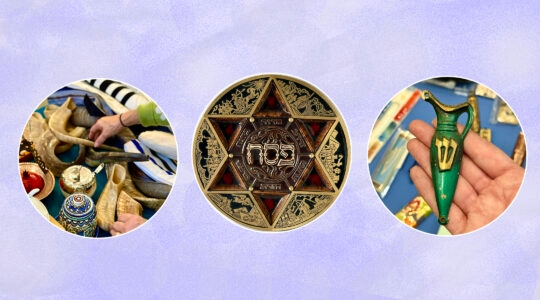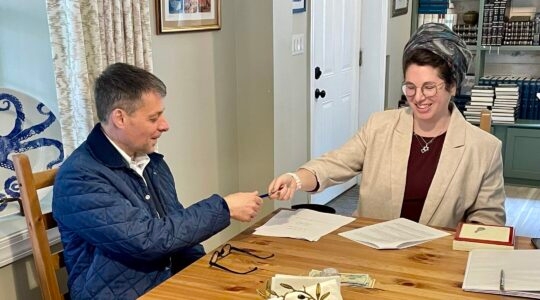The first Mishnah in Pirkei Avos states that “Moshe Rabbeinu received the Torah from Har Sinai and transmitted it to Yehoshua, and Yehoshua to the Elders, and the Elders to the Prophets, and the Prophets transmitted it to the Men of the Great Assemble”[1]. This “transmission” comes from the Hebrew words mesorah. But what does that really mean? Is it a a clear, direct copy-and-paste from one generation to the next? Or is the mesorah able to evolve as time moves on?
JOFA’s recent blogcast[2] attempted to answer those questions by bringing in four fascinating individuals to blog their thoughts on the matter. Those individuals included Rabbi Noah Gradofsky, esq of the Union for Traditional Judaism, Rabbi Aryeh Klapper of the Center for Modern Torah Leadership, Rav Aviva Richman of Yeshivat Hadar, and author Leah Vincent. Each of the bloggers brought their own unique perspectives on the topic, ranging from a rejection of the mesorah that they were raised with to straight-forwardly viewing the mesorah as any texts, laws, lore, behaviors or that were passed down to us from prior generations. This blog post will focus on the panelists’ views on the ideal interaction between the received mesorah and the contemporary society that we live in.
On that topic, Rabbi Gradofsky wrote that he firmly believed that written legal texts should take precedence over the accepted practices of a community. Rabbi Gradofsky stated in no uncertain terms that “I think it important to always check those attitudes and practices against our texts since, as a general rule, I think texts are a more reliable guide to understanding Torah and halakha and ultimately, God’s will.”
“Mesorah isn’t necessarily handed to us on a silver platter, but is something we have to reach for.” -R’ Aviva Richman
Rav Richman then shared her opinion that “mesorah isn’t necessarily handed to us on a silver platter, but is something we have to reach for. Often, this gap can feel like a loss. Instead of mourning this gap, and seeing a clash between mimesis and text, I see the larger endeavor of Talmud Torah in our times as part of claiming out mesorah.” Leah Vincent agreed with Rav Richman’s notion and described the mesorah as “a plot of land passed down from generation to generation, a kind of cultural Garden of Eden for us to tend, that is rich and ever-changing with an ecology of ancient wisdom, new ideas, noxious weeds, and life-giving fruit.”
“I don’t really see a conflict between culture and text, rather an ongoing dance in which each recognizes the necessity of partnering, although they may disagree as to who gets to lead.” -R’ Aryeh Klapper
Lastly, Rabbi Klapper wrote that “I don’t really see a conflict between culture and text, rather an ongoing dance in which each recognizes the necessity of partnering, although they may disagree as to who gets to lead.” This is a particularly nuanced view which acknowledges both the human and textual elements of the application of the mesorah in our day and age. It recognizes that there are legitimate issues that come into play when one tries to adapt our handed-down laws and traditions to the times that we live in which are so different than when those laws and traditions were first commanded. This view also recognizes that there will always be those who think that the mesorah should yield to the culture and those who think that the culture should yield to the mesorah. The power is neither in the hands of us humans to cultivate the mesorah to be what we think it should be, nor is it entirely in the hands of the precedent as it was when first given. A partnership is required for Judaism to both preserve the mesorah and live in modern times. At face value, this view also seems to give the received texts and traditions more of a say in the process than the views of Rav Richman or Leah Vincent, though it seems to give culture more power than the view of Rabbi Gradofsky.
I would now like to compare this view of mesorah to a certain recently-expressed position. Many within the Orthodox community know that the Orthodox Union recently put together a panel of poskim[3] to weigh-in on the question of whether or not women can be ordained as Orthodox rabbis. While, it is not my place to write about my own opinion of the resulting psak in this blog post[4], I think that part of methodology used by the OU panel is relevant to this discussion. When weighing various concerns, one section of the OU’s psak was dedicated to the topic of mesorah, writing as follows:
“Authentic mesorah is rather an appreciation for, and application of, tradition as the guide by which new ideas, challenges and circumstances are navigated.” -The Orthodox Union
“The idea of mesorah is often mistaken as a mere historical record of Jewish practice. That misunderstanding, combined with both the absence of historical uniformity of normative practice, and the gradual evolution of halakha, can be misconstrued as compromising the authenticity of mesorah. Authentic mesorah is rather an appreciation for, and application of, tradition as the guide by which new ideas, challenges and circumstances are navigated.” [5]
Interestingly, the OU panel’s definition of mesorah as a guiding force in the application of tradition to help navigate new challenges and circumstances is one that fits very nicely with the definitions offered by nearly all the JOFA panelists[6]. The OU’s definition of mesorah clearly parallels Rabbi Klapper’s metaphor of mesorah as a dance between religious text and contemporary culture with the religious texts leading the dance with the aid of mesorah. This definition can also be applied to Rav Richman and Leah Vincent’s definitions of mesorah as something that has to be claimed and cultivated. In this case, the tools needed to help with the cultivation are the traditions of the past as applied to the current situation.
The two sides constantly write about each other, but never seem to directly engage in dialogue with the other.
Often, issues of feminism in halakha and how the mesorah is applied to those issues are spoken of only from one perspective or the other. The two sides constantly write about each other, but never seem to directly engage in dialogue with the other. Arguments of one side are often completely skipped over or are never addressed substantially[7].
If the Modern Orthodoxy is to continue to live together as one community, its adherents must learn to talk to each other rather than over each other.
If the Modern Orthodoxy (including the “Open”, “Centrist”, and “Right-Wing” varieties) is to continue to live together as one community, its adherents (myself included) must learn to talk to each other rather than over each other. Talking to each other involves understanding where the other side is coming from and acknowledging that despite the perceived differences, there are many similarities in worldviews. Those similarities are apparent in the fact that we are still speaking about mesorah from the same starting point, despite differing in our ideal applications of it.
Modern Orthodoxy may contain communities that vary greatly in their practices and application of the mesorah to today’s issues[8], but the fact that we are still talking about the same thing when we talk about mesorah is no small feat. It can be the opening of a door to future conversations and the first steps leading to back path together as one cohesive community. Once we lose the ability to talk to those that we disagree with, we can no longer be considered one community. Modern Orthodoxy has always had a strong mesorah of being able to talk issues out in intelligent and respectful ways, without having to resort to rhetoric or writing well-meaning, halakhically-observant Jews out of the community. Now would be a horrible time to lose that mesorah, especially since we can still agree on so much. One must not agree with the other side completely, but they must always be able to talk to them.
JOFA and the OU are clearly still speaking the same language, but will they be able to keep talking to each other? Only the people on the ground can say. It is my hope that we can all embrace our mesorah of dialogue and apply it to keep the Modern Orthodox community together in such trying days.
Steve Gotlib is currently in his senior year at Rutgers University, where he is studying Jewish Studies, Communication, and Philosophy. Beginning in 2018, he will be studying at Yeshiva University’s Rabbi Isaac Elchanan Theological Seminary with the hopes of one day serving as a community rabbi.
[1] Avot 1:1 משֶׁה קִבֵּל תּוֹרָה מִסִּינַי, וּמְסָרָהּ לִיהוֹשֻׁעַ, וִיהוֹשֻׁעַ לִזְקֵנִים, וּזְקֵנִים לִנְבִיאִים, וּנְבִיאִים מְסָרוּהָ לְאַנְשֵׁי כְנֶסֶת הַגְּדוֹלָה.
[2] The blogcast can be found here: https://www.replyall.me/jofas-cast/mesorah/.
[3] Consisting of Rabbi Daniel Feldman, Rabbi Yaakov Neuberger, Rabbi Michael Rosensweig, Rabbi Ezra Schwartz, Rabbi Gedalia Dov Schwartz, Rabbi Hershel Schachter, and Rabbi Benjamin Yudin.
[4] For those interested in said opinion, I support the OU’s decision fully. That support, however, does not stop me from seeking out dialogue with those I disagree with.
[5] The full response of the rabbinic panel can be found here: https://www.ou.org/assets/Responses-of-Rabbinic-Panel.pdf
[6] While it is clear from the psak that the OU agree with Rabbi Gradofsky about not allowing contemporary culture to trump the texts that have been handed down to us (most notably, the Rambam on serara), the definition of mesorah that they provide does not directly state this
[7] For example, compare the OU psak to the following psak of Rabbi Jeffrey Fox on women’s ordination and notice how many of his points are never addressed in the OU paper. This does not weaken the arguments that the OU panel did make, but it shows that the two sides are talking over each other rather than two each other in many cases. https://static1.squarespace.com/static/5348363de4b0531dce75bc53/t/56f98a945f43a661a42076f4/1459194516989/160328_Women+and+Semikha.pdf
[8] Even to the point of thinking another community is doing something assur by taking a minimalist view on serara.
Posts are contributed by third parties. The opinions and facts in them are presented solely by the authors and JOFA assumes no responsibility for them.
If you’re interested in writing for JOFA’s blog contact shira@jofa.org. For more about JOFA like us on Facebook or visit our website.
The New York Jewish Week brings you the stories behind the headlines, keeping you connected to Jewish life in New York. Help sustain the reporting you trust by donating today.




